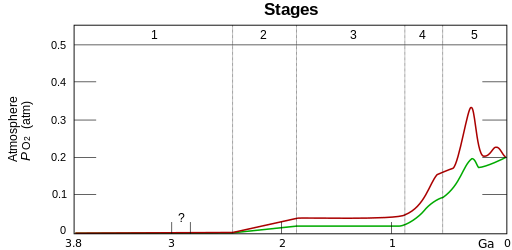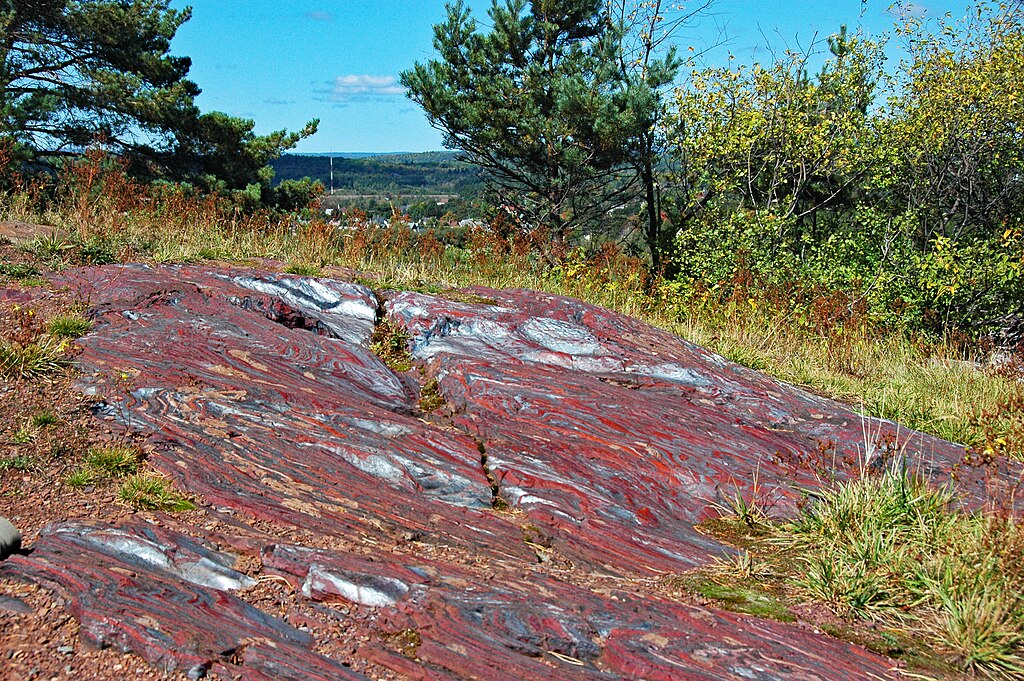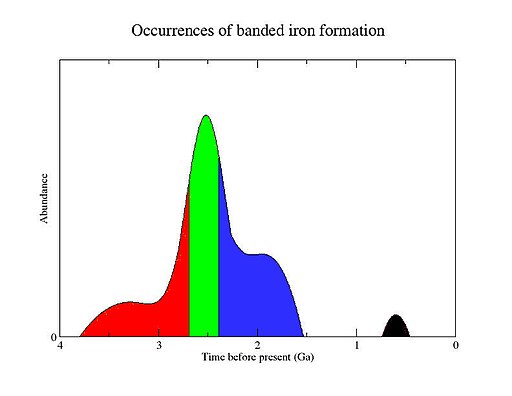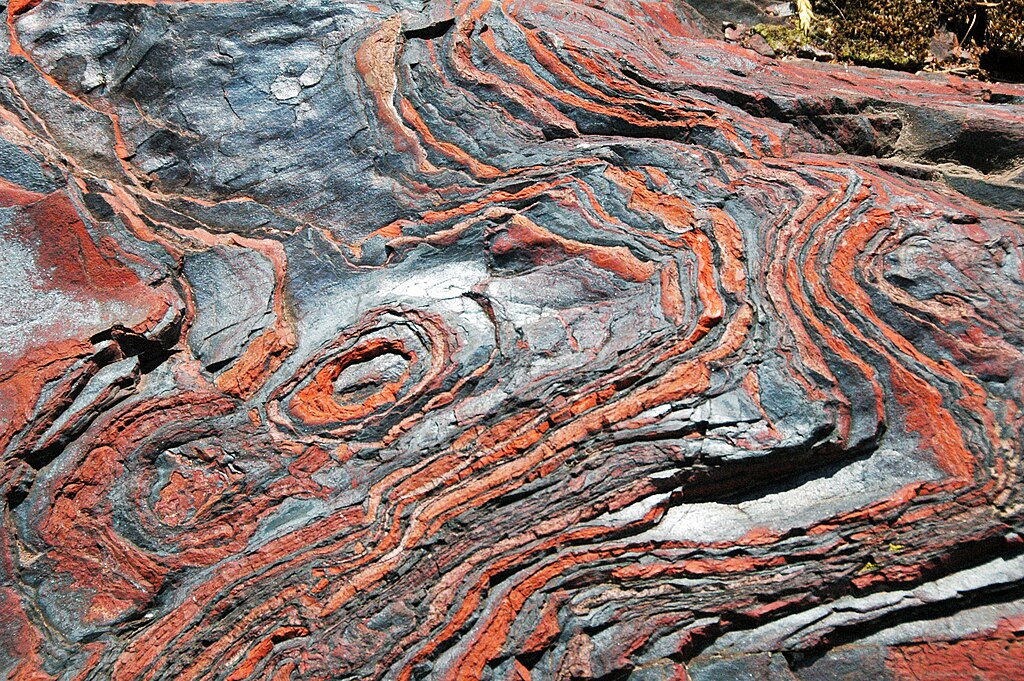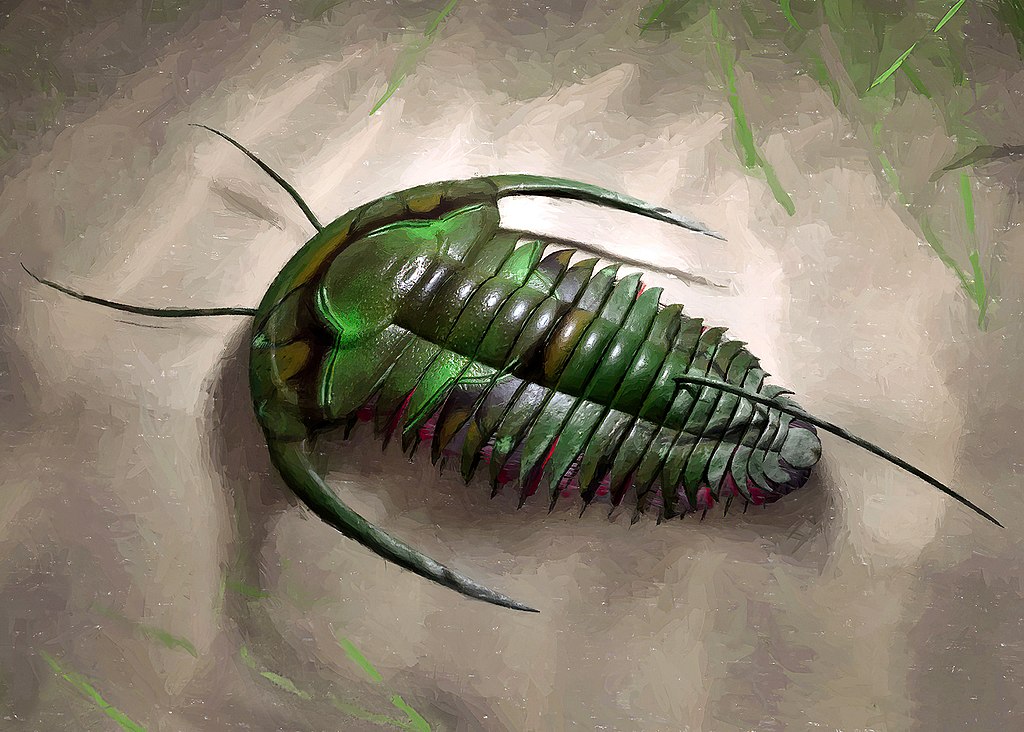After the Ediacaran and the small shellies; in the Cambrian, oxygen in the sea finally reached a level where gilled animals could breathe efficiently and grow big. This oxygen was created by life itself, through photosynthesis.
Is it possible to say something about how animals evolved based on the data we have, and why animal diversity suddenly exploded?
We can make a story out of all this, like Hercule Poirot fitting together information that seems random into a clear picture. The story fits the data and tells why the Cambrian explosion was fast, at least on a geological timescale. We just do not know if it is right.
Oxygen content in the amosphere through time.
(Oxygenation-atm.svg: Heinrich D. Hollandderivative work: Loudubewe, CC BY-SA 3.0, via Wikimedia Commons)
Multicellular life evolved early, although we do not know exactly when:
Trace fossils, burrows and creep traces may suggest up to 2.1 billion years ago, were likely made by large amoeboid cells. These very old fossils, from Gabon in Africa, also carries the problem that we do not see them again before the end of the Ediacaran, around 560 m.a..
There is other evidence:
Fossils of what appears to be large sea algae are found in Yanshan in North China, in shales that are at least 1,56 Billion years old. Such algae appear also in “only” 1,3 Billion years old rocks in Montana.
And, then there is chemical evidence:
The chemical 26-methylstigmastane is known only from sponges. In Oman, it has been found in rocks well beneath the Marionan snowball rocks, which suggests that multicellular life was in place at least before ca 635 m.a.
There are more snapshots around the world, of course, which indicate that multicellular life evolved very early. The further back we go, the more fragmented is the evidence, but we can quite safely conclude that multicellular life evolved long before the Cambrian explosion. Then, not much seems to have happened, evolution wise, before the Ediacaran – at least not what we see in fossils.
Then, in the Ediacaran, life exploded, including trace fossils into a large variety of shapes and sizes, which must reflect an explosion in different soft organisms.
Why?
The Earth has frozen over at least three times, and we visited these Snowball Earths in previous blog posts. There have been speculations that the Snowball Earths triggered leaps in evolution: The first snowball 2,45 Billion years ago triggered the merge of procaryote cells to eucaryotes. The Sturtian (ca 715-660 m.a.) or Marinoan (ca 650-635 m.a.) glaciations triggered the merger of cells to create multicellular life, and the Gaskiers glaciation (although probably not a full snowball, around 580 m.a.) triggered the Ediacarans. Supposedly, the snowballs stressed life, but allowed the fittest to survive by evolutionary inventions.
But, the timing of the snowballs is coarse-grained. And what would be the causal mechanism for the changes? How would cold cause cells to merge? Why would it be advantageous? On Earth today, it is the simplest of algae, which survive in the coldest climates, including inside glacier ice itself.
The snowballs did of course cause mass dying of life – how could they not? – but their actual influence on evolution is elusive.
When evolution developed multicellular life, it took a long time to the Eadiacaran fauna, and then nearly 60 million more years to make the Cambrian animals – real animals, as we know them, with legs and claws.
One possible answer to the lag is oxygen. Or, the lack of it.
Evolution needs energy. Complex organisms, with muscles that move to swim, walk and chew, need energy both to make muscles and to keep going. All this needs a brain to coordinate, and the brain needs energy.
To get this energy, animals need metabolism and that needs oxygen.
The young Earth had no oxygen in the atmosphere. All the oxygen we breathe is made by life itself – namely the procaryote cyanobacteria.
(Wilhelm Barthlott, CC BY-SA 4.0, via Wikimedia Commons)
Cyanobacteria invented photosynthesis early, but how early is a matter of much debate. Around 2,45 billion years ago, oxygen in the atmosphere crawled from essentially zero to ca 2%, in what we call The Great Oxydation Event. (Or, The Great Oxygenation Event). Why it happened then is uncertain, but we know it happened because sedimentary rocks record it. Before, there are sedimentary rocks with grains of pyrite, aka “fool’s gold”. Pyrite is an iron sulphide, FeS2, and in younger sediments it is gone, because it is broken down to rust and sulphates.
Another thing that happened then was that Banded Iron Formations – BIFs for short – became common.
Banded Iron Formations are marine sediments, coloured red by many bands of iron oxides, a.k.a. rust. BIFs are the world’s most important iron ores. They also trace the ups and downs of the oxygen content in the seas.
Banded Iron Formations in Michigan, USA.
(James St. John, CC BY 2.0, via Wikimedia Commons)
In a world without oxygen, iron ions could stay free in the water, but when oxygen entered, BIFs started to form because the oxygen reacted with dissolved iron in the sea water, and created a rain of rust to the sea bottom.
The first BIFs appear very early, down in the Archean, up to 3,8 billion years ago. From around 3,6 billion years, their abundance rise, up to the peak at 2,45, at the time of the Great Oxidation Event. BIFs then settled at a steady rate until ca 1,8 billion years – and went away. Since then, they only made brief cameos after the snowball Earths.
Occurences of Banded Iron Formations through time.
(Kent G. Budge, CC0, via Wikimedia Commons)
What does this BIF pattern mean?
The generally accepted model – glossing over details – is that the oceans were stratified, layered, with a shallow top layer where photosynthesizing bacteria lived, but with the rest of the oceans being anoxic, void of any oxygen. Hot springs on themed-ocean ridges fed the ocean water with iron, which welled up and met the oxygen near the surface, rusted and then settled as the bands of the BIFs on the ocean floor.
Clearly, the very early appearance of BIFs suggests that photosynthesis evolved very early.. The peak suggests that much more oxygen became available in the seas, leading to much increased iron oxidation during that time. The cease of the BIFs around 1,6 billion years ago suggests that the seas became void of iron – the precipitation finished, because the whole ocean finally was filled with oxygen.
Only during the snowballs, there was some accumulation of iron in the seas, because the photosynthetic cyanobacteria nearly froze to death, and this iron was precipitated when life awoke again.
Neat model, but we need to address some devils in the details.
The BIFs are not even. They consist of many bands of iron oxide, with thin bands of other sediments in between. Clearly, BIF deposition was on and off.
The thinnest bands may be varves due to annual variations in biological activity in the shallowest sea, which in turned created an annual up and down in oxygen supply. But for the thicker band variations, the causes may be variations in mid-ocean ridges output of iron, or a secondary effect, that the sediments chemically separated when they were buried and compacted.
Another reason for the on-and-off rust bands is that the cyanobacteria had not yet evolved the ability to survive the very oxygen they produced. These bacteria made their own poison. As long as there was enough iron in solution, the oxygen was removed immediately and precipitated as rust bands. But, when the iron was depleted, oxygen built up and killed off most of the bacteria. Which in turn halted the oxygen production, so the dissolved iron built up again, which in turn allowed the bacteria to thrive… and so the cycle went for millions of years, iron band for iron band.
Life that makes its own deadly poison? Makes no sense?
Photosynthesis likely started with using sulfur atoms from hydrogen sulfide. Only later, it replaced oxygen atoms from water, because it is more energy efficient. But this improvement demanded that the deadly poison could immediately be removed, and it was removed, by the reaction with iron to make the BIFs.
Then, there was the big change. BIF deposition skyrocketed to a peak at around 2,45 billion years ago, and then waned off until BIFs largely disappeared around 1,6 billion years ago. Meanwhile, the oxygen content in the atmosphere rose to 2-4% at ca 1,8 billion years ago. It stayed so for a full billion years.
This probably happened because, around 2,3 billion years ago, cyanobacteria evolved to tolerate their self-made poison. They could make as much oxygen they wanted, which was very much, since bacteria’s will is limited to becoming as many as possible. With increased supply of oxygen to the ocean, more iron could oxidize and fall out.
BIFs largely ended around 1,6 billion years ago, but not because the oceans became empty of iron. Oceans never become finally empty of iron, because it is continuously supplied by mid-ocean ridge vents. Instead, the shallow and deeper waters finally mixed. Oxygen filled the oceans. Iron no longer welled up to the shallow water, it deposited almost immediately. BIFs went away and the oxygen in the ocean started a long rise, up to the Cambrian.
More Banded Iron Formations in Michigan, USA.
(James St. John, CC BY 2.0, via Wikimedia Commons)
Along the way, the earth froze over three times, the snowball Earths. The first snowball, the Makganyene glaciation, started 2,42 billion years ago, and it may have happened partly because of the Great oxygenation event.
When oxygen finally filled the oceans, it finally also started to fill the atmosphere. The young atmosphere was probably richer in methane, which is a 25 times stronger greenhouse gas than CO2. It may sound absurd to us, in this time when we are worried about global warming created by CO2, but when the oxygen reacted with the methane to create CO2, the net result was thus a decrease in the Earth’s greenhouse effect, cooling the planet.
It was probably not the only reason. The configuration of the continents so far back is difficult to know, but as we saw in the previous blog posts about climate and the later snowballs, we know that continents being aligned around the Equator, lots of rifting or mountain building exposing fresh rock to weathering, or changes in ocean currents can cool the Earth. Still, it is a somewhat absurd thought that life itself would plunge the Earth into a severe ice age – although it also happened later, but not so severe.
Around 830 m.a., the oxygen level rose again, up to around 10%, although the ride was bumpy. During the two late Sturtian (ca 715-660 m.a.) and Marinoan (ca 650-635 m.a.) snowballs, biological activity again nearly died out, and with photosynthesis literally put on ice, iron once again accumulated in the oceans. When the Earth thawed, BIFs made a temporary comeback as that iron oxidised.
After the snowballs, the oxygen content of the atmosphere climbed towards ca 15% around 600 m.a., and then 20% into the Cambrian. The Ediacarans thrived from 575 up to the base of the Cambrian.
The answer to “why not higher life before” is thus possibly that it was not possible before, because there was not enough oxygen in the sea and atmosphere. Evolution could not build and use the hardware without power supply.
It was first when oxygen levels rose high enough to support metabolism, that there was any point for evolution make anything advanced.
Otherwise, even if mutations somehow had created animals with e.g. legs and jaws before, these features would be a drag the animal could not use.
Oxygen may answer the question of “why not before”. But there is still a lag to the explosion of animals as we know them; to the the Ediacarans, and finally the Cambrian explosion.
To attempt to explain this lag, we may turn the problem around: Now the energy supply was in place, but that did not itself make the hardware – or software. In biological terms: Oxygen was necessary for animals to evolve, but animal evolution also needed the time for the genetic evolution, to write the code for evolving animals – for muscles, hearts, eyes, blood vessels, legs, shells…
With all these pieces of evidence and evolutionary logic, we can puzzle together a story for why the Cambrian explosion needed such a long fuse – and then took off fast:
Animals could not evolve before oxygen rose at ca 800 m.a., and were also inhibited by the snowballs.
In the mid Ediacaran, the first possible bilaterans appear, like Spriggina and Kimberella. These may – may – be ancestors to later arthropods. Towards the late Ediacaran, the first hard skeletons appeared in Namacalathus and Cloudina, and in the phosphate “small shellies”. Life had evolved to excrete hard materials, like calcite, phosphate and chitine). These hard material made possible the rapid evolution of the Cambrian explosion.
The first hard pieces may have been teeth – or teeth precursors, small hard dots. With these, an otherwise soft organism could easier eat another softie. This teeth organism may have been a worm, a Spriggina, a Kimberrella – something with a primitive digestion system. But this something changed the whole ecosystem.
Hard parts put evolution into overdrive. When predators got teeth, prey got shells for protection. Predators got bigger teeth to chew through, and bigger claws to chop.
Shells also are mounts for muscles. Muscles move legs and jaws, but they need to be fastened to something rigid.
Legs made the hunt fast, legs allowed prey to escape.
The trilobite Eoredlichia intermedia in life: The hard shells give protection, and are mounts for the legs.
(Віщун, CC BY-SA 4.0, via Wikimedia Commons)
Eyes were a useful supplement, making the search for prey more effective, and the prey could spot the predator earlier and run away faster. Which in turn needs an energy-hungry brain to process the image from the eyes.
Since then, evolution has been a game where everyone has to run faster than everyone else. As the Red Queen said to Alice: “It takes all the running you can do to keep in the same place”. When the first animal developed shells, legs-ish, and teet-ish, everyone else had to follow up – or die out.
Hard shells made this arms race possible. First chitine, the hard stuff of our nails, which likely made the hard parts of Burgessians. It gave them claws and bite, but does not fossilize easily. Then, shells of really hard aragonite and calcite took over, and these make the common fossils of invertebrates.
Another reason for why evolution went so fast in the Cambrian explosion is that ecological niches were open for exploration and exploitation in the Early Cambrian. An evolutionary home alone party, with room for lots of experiment. Later, when the niches were filled, did also the grown-ups come home and stop the party – natural selection started to winnow out the bizarros, a process that lasted at least into the Ordovician and the Fezuoata fauna.
Since the Cambrian explosion, evolution has rarely had the same opportunity for a home alone party. With ecological niches filled, competition was tough, the room for bizarro inventions smaller, and inventions more incremental.
But, as any six-year old knows, there are exceptions. The big extinctions partly reset life, and provided room for the survivors to once again spread out and experiment. The end-Permian extinction paved the way for both dinosaurs and the first tiny mammals. The end-Cretaceous extinction had the dinosaurs give way to big mammals – and finally to us.
